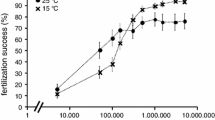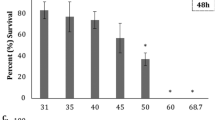Abstract
Food autonomy represents an essential challenge for the future Moon Village planned by the European Space Agency. Rearing fish on the moon to provide essential amino acids, omega-3 polyunsaturated fatty acids and vitamin B12 could become a reality using integrated multi-trophic aquaculture (IMTA). The Lunar Hatch programme’s goal is to fertilize farmed fish eggs on Earth that would hatch upon arrival at the lunar base. However, the vibrations from a spacecraft’s launch are an unusual situation for fish eggs and may have a negative impact on them. European sea bass (Dicentrarchus labrax) and meagre (Argyrosomus regius) eggs were exposed to mechanical stresses using standard protocol performed to approve a satellite for space launch. The hatching rate was evaluated after vibration expositions at different hours post fertilization (hpf). An initial series of tests subjecting the eggs to orbital rotation demonstrated their integrity. In subsequent tests, mechanical stressors acting on the Soyuz spacecraft was simulated to test impact on fish eggs. The results showed egg robustness for European sea bass at 35 hpf (one-third of the embryo development) and 83 hpf (two thirds) and of meagre at 14 hpf (one third), with no significant difference in hatching rate compared with an unshaken control batch. European sea bass embryos and potentially other fish species with similar incubation periods (4–6 days) seem to be good candidates to surviving a spacecraft launch. This paper discusses the findings and suggests possible future research avenues.






Similar content being viewed by others
References
Arthur R (2009) Omega-3 sources. J Complement Med 8:28
Baiocco G et al (2018) A water-filled garment to protect astronauts during interplanetary missions tested on board the ISS. Life Sci Space Res 18:1–11. https://doi.org/10.1016/j.lssr.2018.04.002
Baranov (2009) The Biorisk experiment: 13-month exposure of resting forms of organism on the outer side of the Russian Segment of the International Space Station: preliminary results. Dokl Biol Sci 426:706–709
Barrett JE, Wells DC, Paulsen AQ, Conrad GW (2000) Embryonic quail eye development in microgravity. J Appl Physiol 88:1614–1622
Basilevsky AT, Abdrakhimov AM, Dorofeeva VA (2012) Water and other volatiles on the moon: a review. Sol Syst Res 46:89–107. https://doi.org/10.1134/s0038094612010017
Baumgarten V (1975) Effect of prolonged weightlessness on the swimming pattern of fish aboard Skylab 3. Aviat Sapce Environ Med 46:902–906
Blum V, Andriske M, Kreuzberg K, Schreibman MP (1995) Animal protein production modules in biological life support systems: novel combined aquaculture techniques based on the closed equilibrated biological aquatic system (CEBAS). Acta Astronautica 36:615–623. https://doi.org/10.1016/0094-5765(95)00150-6
Brown N, Eddy S, Plaud S (2011) Utilization of waste from a marine recirculating fish culture system as a feed source for the polychaete worm, Nereis virens. Aquaculture 322:177–183. https://doi.org/10.1016/j.aquaculture.2011.09.017
Chatani M et al (2015) Microgravity promotes osteoclast activity in medaka fish reared at the international space station. Sci Rep 5:14172. https://doi.org/10.1038/srep14172
Dallaire V, Lessard P, Vandenberg G, de la Noue J (2007) Effect of algal incorporation on growth, survival and carcass composition of rainbow trout (Oncorhynchus mykiss) fry. Bioresour Technol 98. https://doi.org/10.1016/j.biortech.2006.05.043
FAO (2018) The state of world fisheries and aquaculture 2018- Meeting the sustainable development goals. Food and Agriculture Organization of the United Nations. Rome, Italy, p 210. http://www.fao.org/3/i9540en/i9540en.pdf Licence: CC BY-NC-SA 3.0 IGO. Accessed 7 Sept 2020
Ghasemi Fard S, Wang FL, Sinclair AJ, Elliott G, Turchini GM (2019) How does high DHA fish oil affect health? A systematic review of evidence. Crit Rev Food Sci Nutr 59:1684–1727. https://doi.org/10.1080/10408398.2018.1425978
Gonzales JM (2009) Aquaculture in bio-regenerative life support systems (BLSS): Considerations. Adv Space Res 43:1250–1255. https://doi.org/10.1016/j.asr.2009.01.034
Gonzales JM, Brown PB (2006) Nile tilapia Oreochromis niloticus as a food source in advanced life support systems: Initial considerations. Adv Space Res 38:1132–1137. https://doi.org/10.1016/j.asr.2005.11.002
Hanson J (1983) Ecology, Aquaculture And Space Colonies Proceedings OCEANS ‘83,San Francisco, CA, pp. 998–1001. https://doi.org/10.1109/OCEANS.1983.1152020
Ijiri K (1998) Development of space-fertilized eggs and formation of primordial germ cells in the embryos of Medaka fish. Adv Space Res 21:1155–1158
Ijiri K, Mizuno R, Eguchi H (2003) Use of an otolith-deficient mutant in studies of fish behavior in microgravity. In: Bruce LL, Ijiri K, Perbal G (eds) Space life sciences: gravitational biology: 2002, vol 32. Advances in Space Research-Series, vol 8. pp. 1501–1512. https://doi.org/10.1016/s0273-1177(03)00623-9
Johnson DS (2016) The first fish in orbit sprinkler/praxis. https://blogs.scientificamerican.com/guest-blog/the-first-fish-in-orbit/. Accessed 7 Sept 2020
Lane HW, Bourland C, Barrett A, Heer M, Smith SM (2013) The role of nutritional research in the success of human space flight. Adv Nutr 4:521–523. https://doi.org/10.3945/an.113.004101
Leys N, Baatout S, Rosier C, Dams A, s’Heeren C, Wattiez R, Mergeay M (2009) The response of Cupriavidus metallidurans CH34 to spaceflight in the international space station Antonie Van Leeuwenhoek. Int J Gen Mol Microbiol 96:227–245. https://doi.org/10.1007/s10482-009-9360-5
Li M et al (2019) Bioremediation of fishpond effluent and production of microalgae for an oyster farm in an innovative recirculating integrated multi-trophic aquaculture system. Aquaculture 504:314–325. https://doi.org/10.1016/j.aquaculture.2019.02.013
Mitrofanov IG, Sanin AB, Litvak ML (2016) Water in the moon’s polar areas: results of LEND neutron telescope mapping. Dokl Phys 61:98–101. https://doi.org/10.1134/s1028335816020117
Mladineo I, Bocina I, Przybyla C, Fievet J, Blancheton JP (2010) Fish growth and health aspects of sea bass (Dicentrarchus labrax) reared in standard vs. high rate algal pond recirculation systems. Aquat Living Resour 23:217–224. https://doi.org/10.1051/alr/2010013
Mylonas CC, Mitrizakis N, Castaldo CA, Cervino CP, Papadaki M, Sigelaki I (2013) Reproduction of hatchery-produced meagre Argyrosomus regius in captivity II. Hormonal induction of spawning and monitoring of spawning kinetics, egg production and egg quality. Aquaculture 414:318–327. https://doi.org/10.1016/j.aquaculture.2013.09.008
Niederwieser T, Kociolek P, Klaus D (2018a) A review of algal research in space. Acta Astronautica 146:359–367. https://doi.org/10.1016/j.actaastro.2018.03.026
Niederwieser T, Kociolek P, Klaus D (2018b) ) Life Sci Space Res 16:8–17. https://doi.org/10.1016/j.lssr.2017.10.002
Nurge MA (2012) In situ dielectric spectroscopy for water detection on the lunar surface. Planet Space Sci 65:76–82. https://doi.org/10.1016/j.pss.2012.01.010
Poughon L, Farges B, Dussap CG, Godia F, Lasseur C (2009) Simulation of the MELiSSA closed loop system as a tool to define its integration strategy. Adv Space Res 44:1392–1403. https://doi.org/10.1016/j.asr.2009.07.021
Poulet L, Fontaine JP, Dussap CG (2016) Plant’s response to space environment: a comprehensive review including mechanistic modelling for future space gardeners. Bot Lett 163:337–347. https://doi.org/10.1080/23818107.2016.1194228
Przybyla C, Fievet J, Callier M, Blancheton J-P (2014) Effect of dietary water content on European sea bass (Dicentrarchus labrax) growth and disease resistance. Aquat Living Resour 27:73–81. https://doi.org/10.1051/alr/2014007
Quinton R (1912) L’eau de mer, milieu organique vol Deuxième édition. Masson et Cie. Editeurs, Paris
Saavedra M et al. (2016) Different dietary protein levels affect meagre (Argyrosomus regius) larval survival and muscle cellularity Aquaculture 450:89–94. https://doi.org/10.1016/j.aquaculture.2015.07.004
Salisbury FB, Clark MAZ (1996) Suggestions for crops grown in controlled ecological life-support systems, based on attractive vegetarian diets. In: MacElroy RD, Kreuzberg K, Nielsen S, Tibbits TW (eds) Natural and artificial ecosystems, vol 18. Advances in Space Research-Series, vol 4/5. pp 33-39. https://doi.org/10.1016/0273-1177(95)00859-d
Scapigliati G, Carcupino M, Taddei AR, Mazzini M (1994) Characterization of the main egg envelope proteins of the sea bass (Dicentrarchus labrax L (teleostea serraniidae) Mol Reprod Dev 38:48–53. https://doi.org/10.1002/mrd.1080380109
Siegler M, Paige D, Williams JP, Bills B (2015) Evolution of lunar polar ice stability. Icarus 255:78–87. https://doi.org/10.1016/j.icarus.2014.09.037
Soyano K, Mushirobira Y (2018) The mechanism of low-temperature tolerance in fish. In: IwayaInoue M, Sakurai M, Uemura M (eds) Survival strategies in extreme cold and desiccation: adaptation mechanisms and their applications, Advances in Experimental Medicine and Biology, vol 1081, pp 149–164. https://doi.org/10.1007/978-981-13-1244-1_9
Stein TP, Blanc S (2011) Does protein supplementation prevent muscle disuse atrophy and loss of strength? Crit Rev Food Sci Nutr 51:828–834. https://doi.org/10.1080/10408398.2010.482679
Tacon AGJ, Metian M (2008) Global overview on the use of fish meal and fish oil in industrially compounded aquafeeds: trends and future prospects. Aquaculture 285:146–158. https://doi.org/10.1016/j.aquaculture.2008.08.015
Tulli F, Zittelli GC, Giorgi G, Poli BM, Tibaldi E, Tredici MR (2012) Effect of the inclusion of dried Tetraselmis suecica on growth, feed utilization, and fillet composition of European sea bass juveniles fed organic diets. J Aquat Food Product Technol 21:188–197. https://doi.org/10.1080/10498850.2012.664803
Vuolo M et al (2017) Exploring innovative radiation shielding approaches in space: a material and design study for a wearable radiation protection spacesuit. Life Sci Space Res 15:69–78. https://doi.org/10.1016/j.lssr.2017.08.003
Zabel P, Bamsey M, Schubert D, Tajmar M (2016) Review and analysis of over 40 years of space plant growth systems. Life Sci Space Res 10:1–16. https://doi.org/10.1016/j.lssr.2016.06.004
Zuidhof MJ, Schneider BL, Carney VL, Korver DR, Robinson FE (2014) Growth, efficiency, and yield of commercial broilers from 1957, 1978, and 2005. Poult Sci 93:2970–2982. https://doi.org/10.3382/ps.2014-04291
Acknowledgements
The Lunar Hatch programme and LAUVE project (2019–2020) are supported by Ifremer. The author would like to sincerely thank Véronique Ribière for her communications consulting expertise, her involvement and her valuable contributions in discussions around the project. A video of the experiment can be viewed at https://www.youtube.com/watch?v=Kwigd9lETmE&feature=youtu.be. In memory of Gilles Futsch (1967–2016), the first supporter of the Lunar Hatch project.
Funding
The experiments were auto-financed by the French institute for the exploration of the sea (Ifremer).
Author information
Authors and Affiliations
Corresponding author
Ethics declarations
Conflict of interest
The authors declare that they have no conflict of interest.
Ethical approval
All applicable international, national and institutional guidelines for the care and use of fish eggs were followed by the authors.
Additional information
Publisher’s note
Springer Nature remains neutral with regard to jurisdictional claims in published maps and institutional affiliations.
Rights and permissions
About this article
Cite this article
Przybyla, C., Dutto, G., Bernard, M. et al. European sea bass (Dicentrarchus labrax) and meagre (Argyrosomus regius) fertilized egg resistance to a spacecraft launcher vibration qualifying test. Aquacult Int 28, 2465–2479 (2020). https://doi.org/10.1007/s10499-020-00601-5
Received:
Accepted:
Published:
Issue Date:
DOI: https://doi.org/10.1007/s10499-020-00601-5




